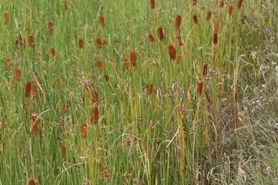Graceful Cattail
(Typha laxmannii)
Graceful cattail is a perennial wetland plant native to marshes and wetlands in Europe and Asia that spreads by creeping rhizomes to form dense colonies in shallow water. It grows 3-5 feet tall, often with a submerged base.
Other names for this plant include:
- Common names: Laxman’s bulrush
- Scientific names: Typha stenophylla
Classification in Wisconsin: Prohibited
- Ecological Threat
-
- Invades freshwater marshes, wet meadows, fens, roadsides, ditches, shallow ponds, streams, and lakeshores.
- It is vital as a food source and shelter for some marsh-dwelling animals, but large mono-specific stands of invasive cattails exclude some less common species.
- Identification
-
Leaves: Narrow green leaves grow linear and sword-like up to 5 feet tall.
Flowers: Yellowish male flowers are located at the top of a flower stalk and greenish female flowers are up to 2 inches underneath.
Fruits & seeds: After pollination, the female flowers turn brown, similar to other cattail species, as the seeds mature. The seeds are tiny (about 1 mm), dispersed by the wind with the aid of numerous hairs.
Roots: Plants can spread vegetatively using starchy underground rhizomes to form large colonies.
Similar species: There are other species of cattail in Wisconsin that may be confused with graceful cattail. Broad-leaved cattail (Typha latifolia) is native to Wisconsin, while narrow-leaved (T. angustifolia) and hybrids (T. glauca) are also considered invasive. Graceful cattail is smaller than the other cattail species, and its fruiting spike is smaller than other species (typically around 4 inches).
- Distribution
-
See the reported locations of graceful cattail in Wisconsin.
Do you know of other populations? Please send us a report.
- Control
-
Mechanical: Cut all stems, green and dead in mid to late summer or early fall. Where possible, maintain a minimum water level of 3” above the cut stems for the entire growing season.
Chemical: Foliar spray with aquatic-approved imazapyr. Herbicide applications near water may require a permit.
- Resources
- Sources for content:
- Missouri Botanical Garden: Graceful Cattail Factsheet [exit DNR]



